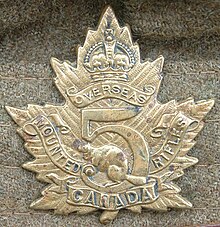5th Battalion, Canadian Mounted Rifles, CEF
This article needs additional citations for verification. (March 2013) |
| 5th Battalion, Canadian Mounted Rifles | |
|---|---|
 Cap badge of the 5th Battalion, Canadian Mounted Rifles | |
| Active | 1914-1919 |
| Country | |
| Branch | Canadian Expeditionary Force |
| Type | Mounted infantry |
| Size | Battalion |
| Part of | 8th Canadian Infantry Brigade |
| March | The British Grenadiers |
| Insignia | |
| Battle patch |  |
The 5th Battalion Canadian Mounted Rifles were a mounted infantry unit of the Canadian Expeditionary Force (CEF) during World War I. The unit was raised from volunteers of the 7th and XIth (Canadian) Hussars from the Eastern Townships of Quebec.[1]
Formed in 1915, they were transported to England later that year. In 1916, they converted to an infantry battalion attached to the 8th Canadian Infantry Brigade, 3rd Canadian Division, CEF (later the Canadian Corps). The battalion saw action in France and Flanders between 1916 and 1918.[1]
Battle honours[]
In 1929-31, well after World War I had ended, Canada assigned battle honours to those units involved in pivotal battles and campaigns during the war. The 5th Canadian Mounted Rifles were accorded the following battle honours:
| 1916 | 1917 | 1918 |
|---|---|---|
| Mount Sorrel | Arras 1917-18 | Amiens |
| Somme 1916 | Vimy 1917 | Scarpe 1918 |
| Flers-Courcelette | Hill 70 | Hindenburg Line |
| Ancre Heights | Ypres 1917 | Canal du Nord |
| Passchendaele | Cambrai 1918 | |
| Valenciennes | ||
| Sambre | ||
| France and Flanders 1915-18 | ||
During the Battle of Passchendale, the 5th Canadian Mounted Rifles fighting strength was reduced by 60% in a single day. Two members of the battalion were awarded the Victoria Cross, the highest decoration for bravery in the British Empire. The citation for George Pearkes, VC, reads as follows:
"During the advance of 30/31 October 1917, as a member of the 5th Canadian Mounted Rifles Battalion, Major George Randolph Pearkes of Watford, Hertfordshire, England, participated in the battle at Passchendaele. He led the troops under his command to capture and consolidate considerably more than the objectives allotted to him. Just prior to the advance, Major Pearkes was wounded in the left thigh. Regardless of his wound, he continued to lead his men with the utmost gallantry, despite many obstacles. At a particular stage of the attack, his further advance was threatened by a strong point which was an objective of the battalion on his left, but which they had not succeeded in capturing. Quickly appreciating the situation, he captured and held this point, thus enabling his further advance to be successfully pushed forward."
and for Charles Smith Rutherford, VC[1][2] during the Hundred Days Offensive:
"On 16 August 1918, as a member of the 5th Canadian Mounted Rifles Battalion, Lt. Charles Smith Rutherford of Colbourne, Ontario, participated in the offensive to take Munchy-le-Preux. Once the objective taken, he went forward alone to reconnoiter, some distance ahead of the assaulting party. Entering the outskirts of the village, he walked straight into an enemy machine-gun section, holding a pill-box, but which was not looking for an attack from that quarter. Lt. Rutherford called immediately for their surrender stating that if not his machine-gunners would open fire immediately. After a brief discussion, the German officer decided to surrender. Lt. Rutherford then ordered that the other German machine-gun position located a little ways up the hill also surrendered; which it was so ordered to do. The entire garrison, consisting of 2 officers and 43 men with 3 machine-guns, was thus captured single-handedly by Lt. Rutherford. When his section arrived at his location, he observed that the right assault party was held up by heavy machine-gun fire from another pill-box. This he attacked with a Lewis-gun section and captured a further 35 prisoners with machine-guns, thus enabling the assault party to continue their advance."
Perpetuation[]
Following World War I, the 5th Canadian Mounted Rifles were perpetuated by the Eastern Townships Mounted Rifles.[3] [4] Following the regiment's conversion to artillery in 1936[3] [4] [5] the battle honours and lineage was passed onto the 7/XI Hussars which were later merged with the Sherbrooke Regiment to form the Sherbrooke Hussars who perpetuate them today.[3] [6]
The memory of the original unit was also perpetuated by its original members in the 5th Canadian Mounted Rifles Association. The association met annually from its formation in 1934 until it disbanded in 1969. The records of the association may be found at the Eastern Townships Research Centre at Bishop's University library, Lennoxville, Quebec.[7]
Notes and references[]

World War I recruitment poster.
- ^ a b c d Regiments.org; 5th CMR
- ^ Canadian Department of National Defence Archived 17 January 2006 at the Wayback Machine
- ^ a b c "Guide to Sources Relating to the Canadian Militia (Infantry, Cavalry, Armored)" (PDF).
- ^ a b "Canadian Mounted Rifles" (PDF).
- ^ Defence, National (15 February 2019). "27th Field Artillery Regiment, RCA". www.canada.ca. Retrieved 7 December 2021.
- ^ Defence, National (29 November 2018). "The Sherbrooke Hussars". www.canada.ca. Retrieved 7 December 2021.
- ^ 5th Canadian Mounted Rifles Association
External links[]
- War diaries of the regiment for 29 July 1915 – 28 February 1917, 01 March 1917 – 31 March 1918, and 01 April 1918 – 17 March 1919 can be viewed on-line, courtesy of Library and Archives Canada.
- Eastern Townships Research Centre.[1]
- Land Forces of Britain, the Empire and Commonwealth.[2]
- Brief history of the 5th Canadian Mounted Rifles Association.[3]
- Photo of the 5th Canadian Mounted Rifles on parade in Sherbrooke, 4 June 1915.[4]
- Cavalry regiments of Canada
- Infantry regiments of Canada
- Former cavalry regiments of Canada
- Former infantry regiments of Canada
- Battalions of the Canadian Expeditionary Force
- Military units and formations of Quebec
- Disbanded Canadian regiments